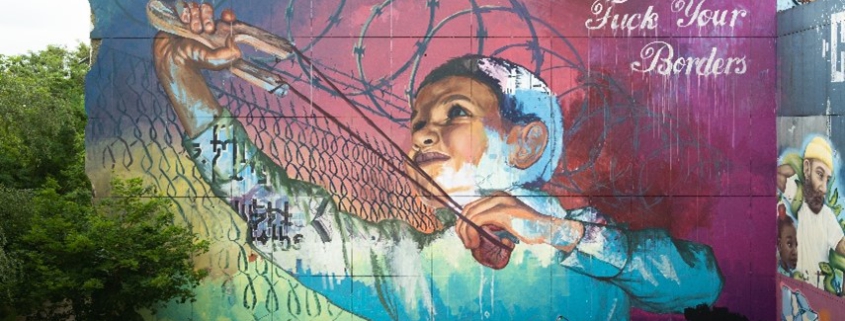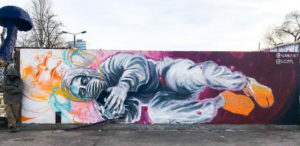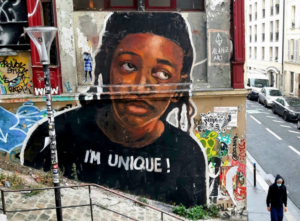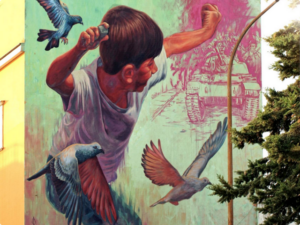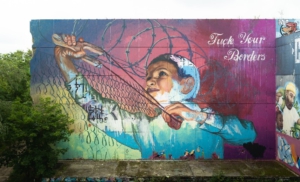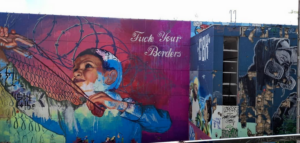Alaniz – Fighting Injustice with Murals
As you stroll through Neukölln, you might notice powerful murals that instantly captivate you. These are likely the work of Alaniz, an Argentinian street artist who once lived here and formed deep connections with the people and places that continue to influence his art. But who is this artist, whose work brings the walls of Berlin and many other cities around the world to life?
From Abandoned Factories to Street Art
Alaniz began his journey in the street art scene in 2011 in Berlin. Without formal art education, he developed his own style in Berlin’s abandoned factories and lost places. These locations offered him the freedom to experiment without constraints. One of these places was Teufelsberg, where he painted the buildings as early as 2011, back when the site was not open to the public. Over the years, Teufelsberg became a creative playground for Alaniz, a place he repeatedly returned to, creating new works and continuing his artistic development. For him, this place is not only a site of artistic creation but also full of personal memories.
During this time, Alaniz discovered the works of Italian street artist Blu, whose monumental murals and innovative techniques deeply influenced him. Alaniz was particularly fascinated by Blu’s use of telescopic poles and paint rollers to create large-scale wall paintings. Alaniz adopted and further developed this technique to leave powerful messages on tall walls.
Another significant influence on Alaniz’s work was the political rock music from his homeland, Argentina. This music, marked by protest and resistance, inspired him to use art as a means of political expression. For Alaniz, his art is not just about aesthetics; it is about conveying important messages and highlighting social injustices. Through his murals, he actively opposes racism, segregation, discrimination, and social inequality.
From the beginning, Alaniz has been driven by a passion for bringing art to people who often have no access to galleries or museums. He sees the streets as his canvas and aims to create a direct connection with his audience through his art. For him, it is crucial that art does not just happen in exclusive galleries but directly on the streets, where it can be seen and experienced by everyone.
Global Connections
Since 2015, Alaniz has led a nomadic life—a lifestyle that can be seen as a statement against borders. He travels from city to city, from country to country, leaving traces of his art everywhere. Although he officially left Berlin in 2016, he continues to return to realize new projects. His works are shaped by the people and traditions he encounters on his travels. He seeks out the commonalities between cultures and expresses these in his murals. For Alaniz, art is a universal language that transcends barriers and brings people together.
Rage and Frustration: Alaniz’s Poetic Critique
One of his most famous murals in Berlin was created in June 2021 and is located on Teufelsberg. This work goes far beyond mere aesthetics and serves as a powerful critique of the injustices perpetrated by so-called First World nations, which use their power and resources to exploit and oppress other countries.
In a poem, Alaniz expresses his anger and frustration with the system: “Fuck your borders, your frontiers, your divisions, your police and your mom’s morality, your church, your government, your fears and insecurities, your ego and your unjustified pride. Fuck your discrimination, your segregation, your religion, your money and your luxurious lifestyle. Fuck your Facebook, your Instagram, your followers, your haters, your stalkers, and your friends. Nothing of that really matters if you invade nations, destroy countries and murder innocents in order to keep your system running. You are the worst scum of earth.”
These words reflect the deep disappointment Alaniz feels about the injustices and inequalities he sees in the world. For him, the borders powerful nations draw symbolize their policies of exclusion and exploitation. Although the technology exists to solve global inequalities, those in power lack the interest in improving people’s lives.
For Alaniz, art is not only an expression but also a tool of resistance and change. Despite the often bleak themes in his work, he remains an artist who believes in the possibility of a better world. “Everyone has their part to play in changing the world,” he says, convinced that even the smallest actions can make a difference.
If you want to learn more about Alaniz and his work, come and experience his art up close—they tell the story of an artist who seeks to change the world through his art.
